ConsciousnessCreatedbyBrainWaves
德里达与塞尔
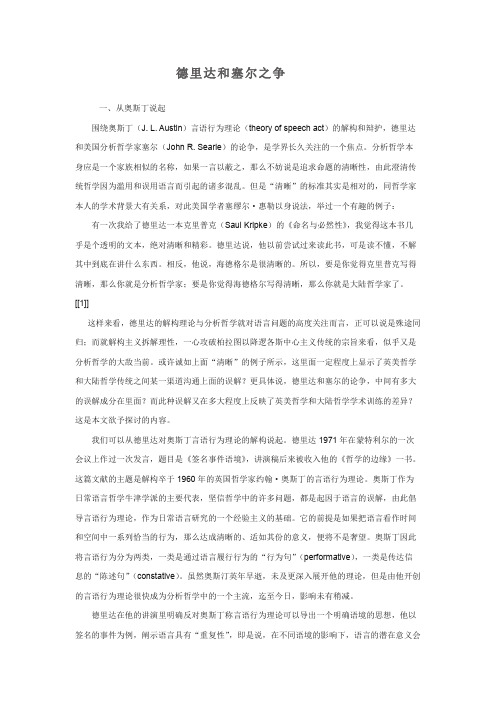
德里达和塞尔之争一、从奥斯丁说起围绕奥斯丁(J. L. Austin)言语行为理论(theory of speech act)的解构和辩护,德里达和美国分析哲学家塞尔(John R. Searle)的论争,是学界长久关注的一个焦点。
分析哲学本身应是一个家族相似的名称,如果一言以蔽之,那么不妨说是追求命题的清晰性,由此澄清传统哲学因为滥用和误用语言而引起的诸多混乱。
但是“清晰”的标准其实是相对的,同哲学家本人的学术背景大有关系,对此美国学者塞缪尔·惠勒以身说法,举过一个有趣的例子:有一次我给了德里达一本克里普克(Saul Kripke)的《命名与必然性》,我觉得这本书几乎是个透明的文本,绝对清晰和精彩。
德里达说,他以前尝试过来读此书,可是读不懂,不解其中到底在讲什么东西。
相反,他说,海德格尔是很清晰的。
所以,要是你觉得克里普克写得清晰,那么你就是分析哲学家;要是你觉得海德格尔写得清晰,那么你就是大陆哲学家了。
[[1]] 这样来看,德里达的解构理论与分析哲学就对语言问题的高度关注而言,正可以说是殊途同归;而就解构主义拆解理性,一心攻破柏拉图以降逻各斯中心主义传统的宗旨来看,似乎又是分析哲学的大敌当前。
或许诚如上面“清晰”的例子所示,这里面一定程度上显示了英美哲学和大陆哲学传统之间某一渠道沟通上面的误解?更具体说,德里达和塞尔的论争,中间有多大的误解成分在里面?而此种误解又在多大程度上反映了英美哲学和大陆哲学学术训练的差异?这是本文欲予探讨的内容。
我们可以从德里达对奥斯丁言语行为理论的解构说起。
德里达1971年在蒙特利尔的一次会议上作过一次发言,题目是《签名事件语境》,讲演稿后来被收入他的《哲学的边缘》一书。
这篇文献的主题是解构卒于1960年的英国哲学家约翰·奥斯丁的言语行为理论。
奥斯丁作为日常语言哲学牛津学派的主要代表,坚信哲学中的许多问题,都是起因于语言的误解,由此倡导言语行为理论,作为日常语言研究的一个经验主义的基础。
2022年6月六级真题第二套
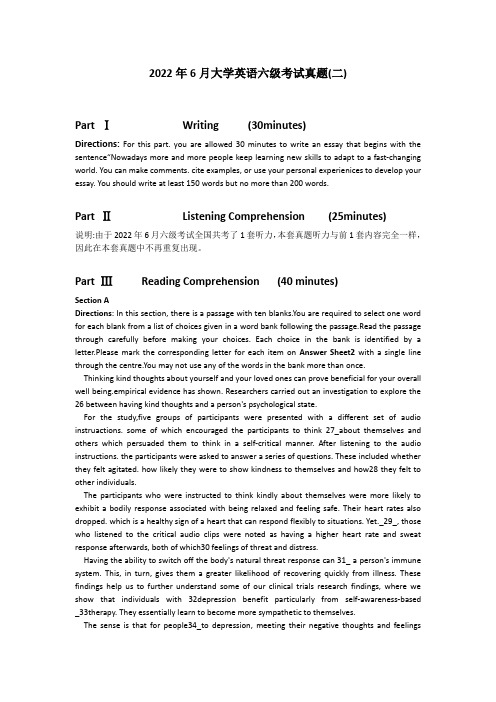
2022年6月大学英语六级考试真题(二)Part ⅠWriting (30minutes)Directions:For this part. you are allowed 30 minutes to write an essay that begins with the sentence“Nowadays more and more people keep learning new skills to adapt to a fast-changing world. You can make comments. cite examples, or use your personal experienices to develop your essay. You should write at least 150 words but no more than 200 words.Part ⅡListening Comprehension (25minutes)说明:由于2022年6月六级考试全国共考了1套听力,本套真题听力与前1套内容完全一样,因此在本套真题中不再重复出现。
Part ⅢReading Comprehension (40 minutes)Section ADirections: In this section, there is a passage with ten blanks.You are required to select one word for each blank from a list of choices given in a word bank following the passage.Read the passage through carefully before making your choices. Each choice in the bank is identified by a letter.Please mark the corresponding letter for each item on Answer Sheet2with a single line through the centre.You may not use any of the words in the bank more than once.Thinking kind thoughts about yourself and your loved ones can prove beneficial for your overall well being.empirical evidence has shown. Researchers carried out an investigation to explore the 26 between having kind thoughts and a person's psychological state.For the study,five groups of participants were presented with a different set of audio instruactions. some of which encouraged the participants to think 27_about themselves and others which persuaded them to think in a self-critical manner. After listening to the audio instructions. the participants were asked to answer a series of questions. These included whether they felt agitated. how likely they were to show kindness to themselves and how28 they felt to other individuals.The participants who were instructed to think kindly about themselves were more likely to exhibit a bodily response associated with being relaxed and feeling safe. Their heart rates also dropped. which is a healthy sign of a heart that can respond flexibly to situations. Yet._29_, those who listened to the critical audio clips were noted as having a higher heart rate and sweat response afterwards, both of which30 feelings of threat and distress.Having the ability to switch off the body's natural threat response can 31_ a person's immune system. This, in turn, gives them a greater likelihood of recovering quickly from illness. These findings help us to further understand some of our clinical trials research findings, where we show that individuals with 32depression benefit particularly from self-awareness-based _33therapy. They essentially learn to become more sympathetic to themselves.The sense is that for people34_to depression, meeting their negative thoughts and feelingswith 35 is a radically different way: that these thoughts are not facts. It introduces a different way of being and knowing that is quite transformative for many people.A)adverselyB)amiablyC) boostD)cognitiveE)compassionF ) connectedG)correlationH)fascinatedI)indignantlyJ)insulationK)lavishL)proneM) recurrentN) signifyO) surpassP) downwardSection BDirections:In this section, you are going to read a passage with ten statements attached to it. Each statement contains information given in one of the paragraphs. Identify the paragraph from which the information is derived. You may choose a paragraph more than once. Each paragraph is marked with a letter: Answer the questions by marking the corresponding letter on Answer Sheet 2.Saving Our PlanetA) In the long view, the human relationship with forests has been one of brutal destruction, but even it carries elements of slow hope. In the Middle Ages, there was no shortage of timber in most parts of the world, and few saw cutting down forests as a problem. Yet in 1548 the people of Venice estimated that an important timber supply would last only 30 years at their current rate of usage一but different forest management would make it possible to meet the demand for many centuries to come. The idea of preserving resources came out of a concern for the future: a fear of using up resources faster than they could be replenished (补充).B) Economic interests were at the core of this understanding of trees and forests. It would take more than three centuries be fore scientists began to understand that timber production is not the only, and possibly not the most important, function of forests. The late 19th and early 20th century saw an increasing recognition that forests serve as habitats for countless animal and plant species that all rely on each other. They take over protective functions against soil erosion and landslides (塌方); they make a significant contribution to the water balance as they prevent surface runoff; they filter dirt particles, greenhouse gases and radioactive substances from the air, they produce oxygen; they provide spaces for recreation and they preserve historic and prehistoric remains. As a result, forests around the world have been set aside as parks or wilderness areas.C) Recent years have seen a big change in our view of forests. Peter Wohlleben's book The Hidden Lijfe of Trees (2015), an international bestseller, suggests that trees can warn each other of danger through a 'wood wide web' of roots and fungi (真菌). They support each other through sharing of nutrients and information, and they even keep ancient stumps alive by feeding them solutions of sugars. Such insights have made us aware of deep ecological and plant species that all rely on each other. They take over protective functions against soil erosion and landslides (塌方); they make a significant contribution to the water balance as they prevent surface runoff; they filter dirt particles, greenhouse gases and radioactive substances from the air, they produce oxygen; they provide spaces for recreation and they preserve historic and prehistoric remains. As a result, forests around the world have been set aside as parks or wilderness areas.D)Recent years have seen a big change in our view of forests. Peter Wohlleben's book The Hidden Lijfe of Trees (2015), an international bestseller, suggests that trees can warn each other of danger through a 'wood wide web' of roots and fungi (真菌). They support each other through sharing of nutrients and information, and they even keep ancient stumps alive by feeding them solutions of sugars. Such insights have made us aware of deep ecological have adopted the term 'environment' over the past decades. They are exploring intricate connections within and between complex ecologies, as well as the impact that human environment-making (through techno-industrial, economic and other manipulative developments) has had on the biosphere.E) The rise of the idea of the environment and a scholarly understanding of ecological processes has influenced new technologies and also politics. We have come to ask questions about vulnerability and risk, world ecologies, and the relationship between nature and power. The search for an adequate response to climate change occupies centre stage in international diplomacy.F) Social and environmental activists, scientists and indigenous groups have called the Paris Agreement of the United Nations Climate Change Conference in December 2015 insufficient, weak, or compromised. To some extent, they are right: climate change has already destroyed tens of thousands of livelihoods, and the situation will worsen in the near future for millions of mostly poorer people who will join the ranks of those who have already been displaced by climate change and extreme weather events. But the Paris Conference nevertheless marked a historic step toward the recognition of the need for action on climate change, the cutting of carbon emissions and world cooperation. There were 195 nations that came to the table in Paris and agreed to limits on emissions. Historically, nothing comparable had happened prior to this. Before the 20th century, a handful of scientists had been interested in the theoretical relationship between greenhouse gases and climate change, but only the empirical evidence accumulated since the late 20th century established a clear connection between the burning of fossil fuels and a vastly accelerated rise in global temperatures.G) The current crisis is not the first that humans have encountered, and a look at the struggles with pollution in recent history reveals transformations that once seemed unimaginable. The 'London fog’ that came to define the capital through British novels and thrillers is in reality smogor smoke, a legacy of industrialisation. After a century of ignorance, London was hit by the Great Smog of December 1952 - the worst air-pollution event in the history of the United Kingdom which caused the deaths of approximately 12,000 people. Shortly thereafter, public initiatives and political campaigns led to strict regulations and new laws, including the Clean Air Act (1956). Today, London has effectively reduced traffic emissions through the introduction of a Congestion Charge Zone in 2003, and an Ultra Low Emission Zone in 2019.H) Scientific evidence that we are living in an era of climate change, resource exhaustion and potential ecological disaster is overwhelming. How do we motivate a public exhausted by never-ending scenarios of doom and disaster, when the challenges seem so huge and so impossible to solve? Statistics about extinction and the gloom of decline will not in themselves get us out of our often self-created ecological traps: instead, they are more likely to result in paralysis and inaction.I) We need stories and histories of change and transformation: ecological stories that make us . confront the fact that human power is potentially destructive, and that the survival of our species on this planet depends on the preservation of soil and water, and the habitats and ecological systems.J) It is time that we show successes and accelerations in ecological awareness, action and restoration; stories that include past successes and future visions about the rise of urban gardening and of renaturalised riverscapes, of successful protests against polluted air and water, of the rise of regional markets and slow food, and the planting of trees around the globe, of initiatives and enterprises that work towards ecological restoration. The reality of ecological curses seems far greater than the power of the hopes left at the bottom of Pandora's box. But if we believe that nothing can be changed, then we are giving up our opportunity to act.K)Today's saving powers will not come from a deusex machina (解围之神). In an ever-more complex and synthetic world, our saving powers won't come from a single source, and certainly not from a too-big-to-fail approach or from those who have been drawn into the whirlpool of our age of speed. Hope can work as a wake up call. It acknowledges setbacks. The concept of slow hope suggests that we can't expect things to change overnight. If the ever-faster exhaustion of natural resources (in ecological terms) and the“ shrinking of the present (in social terms) are urgent problems of humans, then cutting down on exhaustive practices and working towards a stretching of the present' will be ways to move forward.36. Climate change has wrought havoc on the lives of tens of thousands of people.37. It took scientists a long time to realise that the function of forests goes far beyond providing humans with timber.38. There is abundant evidence that we are now facing a possible ecological disaster.39. Environmental science became academic disciplines only some sixty years ago.40. Things cannot change overnight, but reducing the consumption of natural resources will help solve the ecological crisis.41. Human perception of forests has undergone a tremendous change in the past years.42. Recent history shows reduction of pollution once seemingly impossible, can actually be accomplished.43. People began to consider preserving natural resources when they feared they would have nothing to use in the future.44. If we doubt our ability to reverse ecological deterioration, we are throwing away the chance to take action.45. How to respond effectively to climate change has become the focus of international diplomacy.Section CDirections: There are 2 passages in this section. Each passage is followed by some questions or unfinished statements. For each of them there are four choices marked A), B), C) and D). You should decide on the best choice and mark the corresponding letter on Answer Sheet 2 with a single line through the centre.Passage OneQuestions 46 to 50 are based on the following passage.Since American idol star Taryn Southern started composing music with AI in 2017, musicians all over the world have begun wondering about the implications of AI and modern technology where music production is concerned. Using AI in the creation of music is perceived by some as a helpful tool and by others as almost“the beginning of the e nd'. In Taryn's case, AI software enabled her to communicate melodies and chords that she didn't know how to put together herself. The end product was therefore a collaborative effort, rather than a piece entirely produced by technology. Taryn's story has a distinctly positive feel that highlights the advantages of using AI in music production. It can serve as a source of inspiration, and as an ideal jumping off point should a musician be hit with writer 's block (文思枯竭).Conversely to seeing AI as a tool, some musicians consider it to be hugely detrimental to the music scene. At the moment, because such technology is still so young, the music it's producing is not necessarily what we want to hear. In short, it's not of great quality. Those who have produced their own music, or even fans of authentic, artistic music, will also argue that a computer could never emulate the work (and human touch) of a true musician.Music has been an integral part of the story of humans for ages; in fact, the first known piece of music is believed to be around 3,400 years old. Songs have long been used as a means of communicating messages and folk stories, covering everything from societal ethics to world history. Since many people see music as such an inherently human expression, it is often considered as too precious to impart onto technology. The thought of a computer generating a ‘random' piece of music that hasn't been painstakingly created by an artist is almost seen as sacrilegious (亵渎神圣的).Regardless of which side of the argument you fall on, it seems likely that the use of AI in music production will only become more frequent. Our modern world is preoccupied with technological advancements. Instead of shying away from the idea of this bleak future, the best approach to take is one of optimism and curiosity. While there are always bound to be stubborn old-school musicians who refuse to use tech, music producers should consider AI as something to be embraced. AI music software is still very much in its infancy, but with more investors interested in the development and outcomes of such technology, and considering the rapid growth rate ofother tech advances in recent years, it's only a matter of time until AI-produced music is seen as the new norm.46. How do some musicians perceive using AI in creating music?A) It would help to produce more music idols.B) It would be detrimental to music production.C) It would hinder the understanding of authentic music.D) It would be the beginning of a new era in music creation.47. What does Taryn Southern's story illustrate?A) AI technology is conducive to music composition.B) Musicians will be unable to create music without high tech.C) Musicians are often at their wits' end in their creative effort.D) AI technology is indispensable to creating melodies and chords.48. Why are some musicians opposed to the use of AI in creating music?A) Music produced with AI technology lacks humanness.B) Music created with AI technology is easily emulated.C) It will depreciate humans' role in music composition.D) It will deplete young musicians' creative inspiration.49. Why do many people think music is too precious to impart to AI technology?A) It cannot be created without pains.B) It cannot be produced at random.C) It is part of human life.D) It is human specific.50. What does the author think of the future of AI music?A) It will continue to arouse the interest of music investors.B) It has the prospect of becoming the norm in the future.C) It will be gradually accepted by old-school musicians.D) It may eventually lose its freshness and appeal.Passage TwoQuestions 51 to 55 are based on the following passage.A few weeks ago, a well-meaning professor tried to explain the physiological process behind viruses and the human body in a tweet and was immediately criticized for a mistake in his information. He then issued an apology and deleted his erroneous tweet. Communicating science beyond the academic bubble is necessary to augmenting public understanding of health and environmental issues and helping individuals make well-informed personal decisions. However, scientists who engage in science communication must acknowledge that even in their area, their expertise is deep but narrow. They need to recognize the constraints in their own knowledge. That is not to suggest that they only write or present on their own research, but rather, that they consult with an expert if the topic is outside of their discipline. Fact-checking with a scientist who works in the specialty will prevent the unintentional spread of misinformation, and the process of doing so may yield interesting new information that can be incorporated.Some have argued that the public is not educated enough to understand scientific information,especially for any complex phenomena, but this is absurd. Science instruction can be found at all levels of public education with most secondary schools offering classes or biology, physics, and chemistry. If anything, social media has shown that the public craves knowledge based on a solid scientific foundation. Even the public discourse that follows most scientific articles shows that online readers can understand even the most baffling of scientific principles.It is equally imperative to emphasize that being an expert on a topic doesn't automatically make a scholar qualified to communicate it to a nonscientific audience. A number of scientists recently have been offering public-aimed explanations of scientific phenomena. Even though they have appropriate credentials, they often do very little in the way of explaining. One biologist shared a complicated analogy involving a library, books, paper, a recipe, ingredients, and a cake to explain the process behind vaccines. Any explanation that requires witen key to keep track of what each item represents is not a clear example for public consumption. Science communication is a science in and of itself. It requires rigorous training and instruction. A scientist should take communication courses that can teach a person how to identify and eliminate jargon and how to develop effective analogies to explain complex concepts. One cannot assume communication expertise - imagine if someone just decided that they were a physicist and started trying to contribute to the field without the necessary background. Doing a poor job communicating science to the public will only create confusion and widen the gap between science and society, a gap that scientists are trying to close.51. What does the author say about communicating science to the general public?A) It will help them to keep abreast of the latest scientific developments.B) It is a necessary means to improve their understanding of scientific issues.C) It will get them more involved in academic debates on environmental problems.D) It is an effective way to augment scientists' influence beyond the academic circle.52. What does the author advise scientists do to deal with topics outside of their specialty?A) Write or present on them from new angles.B) Utilize information from diverse sources.C) Tum to a specialist for professional help.D) Fact-check with colleagues in their field.53. What does the author say we can learn from social media?A) A solid academic foundation is essential to understanding bffling scientific principles.B) Modern technology has facilitated communication between scientists and the public.C) Scientific articles have gained increasing popularity among the general public.D) The public's understanding of science is much better than some have claimed.54. What does the example of the biologist who shared an intricate analogy show?A) It is helpful to use ilustrations in explaining scientific phenomena.B) It is imperative to have appropriate titles to explain scientific issues.C) A learned scholar is not necessarily a qualified science communicator.D) A nonscientific audience cannot duly understand principles of science.55. What does the author suggest scientists do to close the gap between science and society?A) Explain complex concepts scientificallyC) Take courses in public speaking.B) Make appropriate use of scientific terms.D) Develop communication skills.Part ⅣTranslation (30minutes)Directions: For this part, you are allowed 30 minutes to translate a passage from Chinese into English. You should write your answer on Answer Sheet 2Directions: For this par, you are allowed 30 mimutes to translate a passage from Chinese into English. You should write your answer on Answer Sheet 2.南京长江大桥是长江上首座由中国设计、采用国产材料建造的铁路、公路两用桥,.上层的4车道公路桥长4589 米,下层的双轨道铁路桥长6772米。
2024届浙江省北斗星盟高三下学期5月阶段性考试英语试题(含答案)
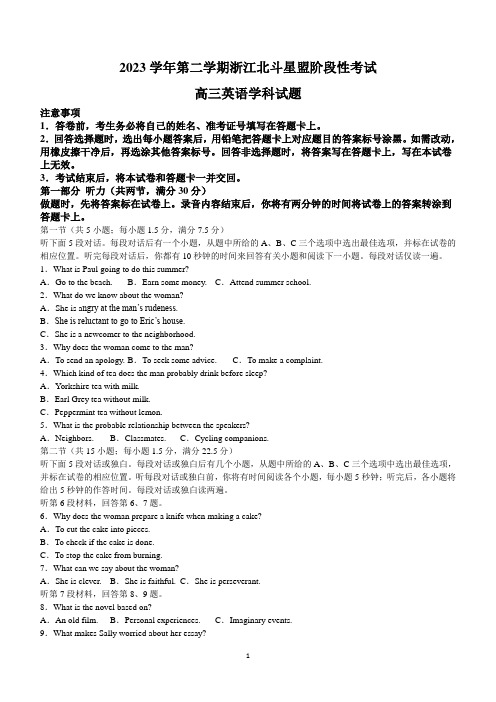
2023学年第二学期浙江北斗星盟阶段性考试高三英语学科试题注意事项1.答卷前,考生务必将自己的姓名、准考证号填写在答题卡上。
2.回答选择题时,选出每小题答案后,用铅笔把答题卡上对应题目的答案标号涂黑。
如需改动,用橡皮擦干净后,再选涂其他答案标号。
回答非选择题时,将答案写在答题卡上,写在本试卷上无效。
3.考试结束后,将本试卷和答题卡一并交回。
第一部分听力(共两节,满分30分)做题时,先将答案标在试卷上。
录音内容结束后,你将有两分钟的时间将试卷上的答案转涂到答题卡上。
第一节(共5小题;每小题1.5分,满分7.5分)听下面5段对话。
每段对话后有一个小题,从题中所给的A、B、C三个选项中选出最佳选项,并标在试卷的相应位置。
听完每段对话后,你都有10秒钟的时间来回答有关小题和阅读下一小题。
每段对话仅读一遍。
1.What is Paul going to do this summer?A.Go to the beach. B.Earn some money. C.Attend summer school.2.What do we know about the woman?A.She is a ngry at the man’s rudeness.B.She is reluctant to go to Eric’s house.C.She is a newcomer to the neighborhood.3.Why does the woman come to the man?A.To send an apology. B.To seek some advice. C.To make a complaint.4.Which kind of tea does the man probably drink before sleep?A.Yorkshire tea with milk.B.Earl Grey tea without milk.C.Peppermint tea without lemon.5.What is the probable relationship between the speakers?A.Neighbors. B.Classmates. C.Cycling companions.第二节(共15小题;每小题1.5分,满分22.5分)听下面5段对话或独白。
阿晃翻译的诗歌
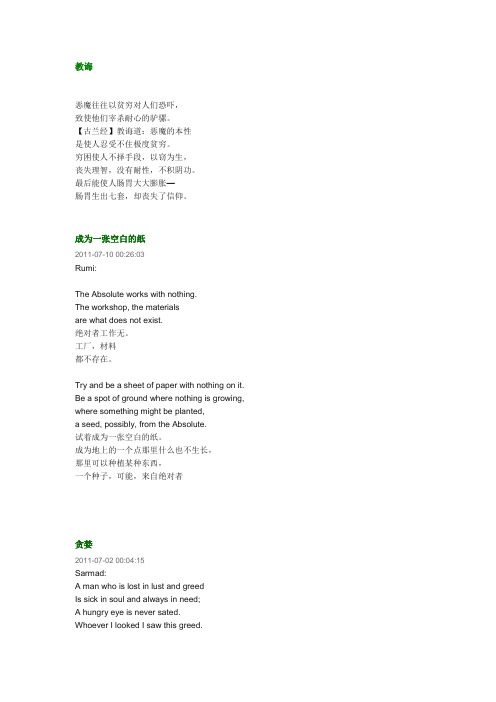
教诲恶魔往往以贫穷对人们恐吓,致使他们宰杀耐心的驴骡。
【古兰经】教诲道:恶魔的本性是使人忍受不住极度贫穷。
穷困使人不择手段,以窃为生,丧失理智,没有耐性,不积阴功。
最后能使人肠胃大大膨胀—肠胃生出七套,却丧失了信仰。
成为一张空白的纸2011-07-10 00:26:03Rumi:The Absolute works with nothing.The workshop, the materialsare what does not exist.绝对者工作无。
工厂,材料都不存在。
Try and be a sheet of paper with nothing on it. Be a spot of ground where nothing is growing, where something might be planted,a seed, possibly, from the Absolute.试着成为一张空白的纸。
成为地上的一个点那里什么也不生长,那里可以种植某种东西,一个种子,可能,来自绝对者贪婪2011-07-02 00:04:15Sarmad:A man who is lost in lust and greedIs sick in soul and always in need;A hungry eye is never sated.Whoever I looked I saw this greed.迷失在情欲和贪婪当中的人他的灵魂病了而总是在需索;饥饿的眼睛永不满足。
不管我看的是谁我都看到这贪婪。
人在哪里?2011-05-12 05:54:33Rumi:The Master roamed the streets With lamp in hand, crying:‗I‘m tired of devil and beast!I demand a man!‘真主在街上四处流浪手里拿着灯,哭喊着:「我已厌倦了魔鬼与野兽!我需要一个人!」我进入了未知2011-03-18 23:46:44John of the Cross:I came into the unknownand stayed there unknowing rising beyond all science.我进入了未知且留在那里保持无知远远超过所有的科学。
超实用备战高考英语考试易错题——阅读理解:主旨大意题(大陷阱) (解析版)

易错点17 阅读理解主旨大意题目录01 易错陷阱(3大陷阱)02 举一反三【易错点提醒一】标题类易混易错点【易错点提醒二】段落大意类易混易错点【易错点提醒三】文章大意类易混易错点03 易错题通关养成良好的答题习惯,是决定高考英语成败的决定性因素之一。
做题前,要认真阅读题目要求、题干和选项,并对答案内容作出合理预测;答题时,切忌跟着感觉走,最好按照题目序号来做,不会的或存在疑问的,要做好标记,要善于发现,找到题目的题眼所在,规范答题,书写工整;答题完毕时,要认真检查,查漏补缺,纠正错误。
易错陷阱1:标题类易混易错点。
【分析】标题类是对中心思想的加工和提炼,可以是单词、短语、也可以是句子。
她的特点是短小精悍,多为短语;涵盖性、精确性强;不能随意改变语言表达的程度和色彩。
如果是短语类选项,考生容易混淆重点,此时应当先划出选项的关键词。
此类题和文章的中心主题句有很大关系。
中心主题句一般出现在第一段,有时第一段也可能引出话题,此时应当重点关注第二段和最后一段,看看是否会出现首尾呼应。
易错陷阱2:段落大意类易混易错点。
【分析】每个段落都有一个中心思想,通常会在段落的第一句或最后一句体现,这就是段落主题句。
如果没有明显的主题句时,应当根据段落内容概括处段落大意。
有时考生还会找错文章对应位置,盲目选词文中相同的词句,而出现文不对题的现象。
易错陷阱3:文章大意类易混易错点。
【分析】确定文章主旨的方法是:先看首尾段或各段开头再看全文找主题句,若无明显主题句,就通过关键词句来概括。
如,议论文中寻找表达作者观点态度的词语,记叙文中寻找概括情节和中心的动词或反映人物特点的形容词。
文中出现不同观点时,要牢记作者的观点彩色体现全文中心的。
此时,要注意转折词,如:but, however, yet, in spite of, on the contrary等。
【易错点提醒一】标题类易混易错点【例1】(浙江省义乌五校2023-2024学年高三联考试题)The scientist’s job is to figure out how the world works, to “torture (拷问)” Nature to reveal her secrets, as the 17th century philosopher Francis Bacon described it. But who are these people in the lab coats (or sports jackets, or T-shirts and jeans) and how do they work? It turns out that there is a good deal of mystery surrounding the mystery-solvers.“One of the greatest mysteries is the question of what it is about human beings — brains, education, culture etc. that makes them capable of doing science at all,” said Colin Allen, a cognitive scientist at Indiana University.Two vital ingredients seem to be necessary to make a scientist: the curiosity to seek out mysteries and the creativity to solve them. “Scientists exhibit a heightened level of curiosity,” reads a 2007 report on scientific creativity. “They go further and deeper into basic questions showing a passion for knowledge for its own sake.” Max Planck, one of the fathers of quantum physics, once said, the scientist “must have a vivid and intuitive imagination, for new ideas are not generated by deduction (推论), but by an artistically creative imagination.”......ong as our best technology for seeing inside the brain requires subjects to lie nearly motionless while surrounded by a giant magnet, we’re only going to make limited pro gress on these questions,” Allen said.What is a suitable title for the text?A.Who Are The Mystery-solversB.Scientists Are Not Born But MadeC.Great Mystery: What Makes A ScientistD.Solving Mysteries: Inside A Scientist's Mind【答案】C【解析】文章标题。
诊断学意识障碍双语

It can be divided three stages 分为三阶段
Three stages of coma 昏迷三阶段
Ⅰmild coma or semicoma Vigorous stimulation may cause a stirring or moaning, reflexes are preserved, ocular movements are obtainable. 轻度昏迷:对疼痛刺激有反应,反射存在,眼球可转动
Etiology
病
Cardiovascular diseases 心血管疾病
因
Imbalance of fluid and electrolyte 水电解质平衡紊乱
Intoxications
外源性中毒
Physical injury or anoxia 物理或缺氧 性损害
Intracranial diseases except infection 颅内非感染性疾病
Slow arousal elicited by speaking to patient or applying a tactile stimulus , response to spoken commands is correct. 可被唤醒,并能正确回答问题,做出各种反应
山东省阳谷县第二中学2025届高考冲刺模拟英语试题含解析

山东省阳谷县第二中学2025届高考冲刺模拟英语试题注意事项:1.答卷前,考生务必将自己的姓名、准考证号填写在答题卡上。
2.回答选择题时,选出每小题答案后,用铅笔把答题卡上对应题目的答案标号涂黑,如需改动,用橡皮擦干净后,再选涂其它答案标号。
回答非选择题时,将答案写在答题卡上,写在本试卷上无效。
3.考试结束后,将本试卷和答题卡一并交回。
第一部分(共20小题,每小题1.5分,满分30分)1.---I usually go there by train.---Why not ________ by ship for a change?A.to try going B.trying to goC.to try and go D.try going2.The Small Goose Pagoda in Xi’an, one of the 22 Silk Road relics located in China, _______ back in 707 during the Tang Dynasty.A.dated B.was datedC.dates D.is dating3.It’s difficult for us to learn a lesson in life ________ we’ve actually had that lesson.A.while B.since C.until D.when4.Don’t leave matches or cigarettes on the table within ______ of children.A.stretch B.expand C.reach D.extend5.Private cars will be required to stay off roads one out of five weekdays ____ the traffic pressure.A.to reduce B.reducing C.reduced D.reduce6.The earthquake in Japan, measuring 9.0 on the Richter Scale, was so violent _______ cause a series of explosions of the nuclear reactors in several power stations.A.to B.that C.as to D.as that7.My uncle finally bought his dream house ______ overlooks a beautiful park.A.which B.where C.who D.what8.--The weather is too cold ___ March this year.-- It was still ___ when I came here years ago.A.for; colder B.in; coldC.in; hot D.for; hotter9.—Alice, why aren’t you at work today?—I a day off.A.have given B.have been given C.gave D.was given10.I was ill that day, otherwise I _______the sports meet.A.took part in B.would have taken part inC.had taken part in D.would take part in11.Our country has launched a campaign to ban smoking in public places, which with some heavy smokers. A.concerns B.was concernedC.concerned D.is concerned12.The film Mei Lanfang, L i Ming plays the starring role,has again drawn the world’s attention to our traditional Chinese art.A.what B.that C.which D.where13.---May I help you?You seem to be having some trouble.----____________,thanks. I think I can manage.A.No problem B.It's all rightC.ok D.No way14.In my driving lesson, a traffic rule that impressed me most is that in no time ________ when the traffic lights turn red.A.all vehicles should stop B.should all vehicles stopC.should stop all vehicles D.should stop all vehicles15.Mr. Smart is believed to be a capable person, who is equal_____ charge of the company very well.A.to take B.to taking C.to be taken D.taking16.—Did you enjoy your journey to Beijing last weekend?—. We had driven more than 3 hours before we found the right way.A.Absolutely B.No way C.Not at all D.With pleasure17.No driving after drinking is a rule that every driver ____________ obey in our country.A.will B.shallC.may D.can18.––Is this tea good cold as well?––______ with ice, this tea is especially delicious.A.Served B.Serving C.Having served D.To be served19.The palace is heavily guarded, because inside its walls ________.A.where sit the European leaders B.the European leaders there sitC.sit the European leaders D.that the European leaders sit20.It really matters _______ he treated the latest failure, for the examination is around the corner.A.if B.thatC.why D.how第二部分阅读理解(满分40分)阅读下列短文,从每题所给的A、B、C、D四个选项中,选出最佳选项。
化身博士读后感英文
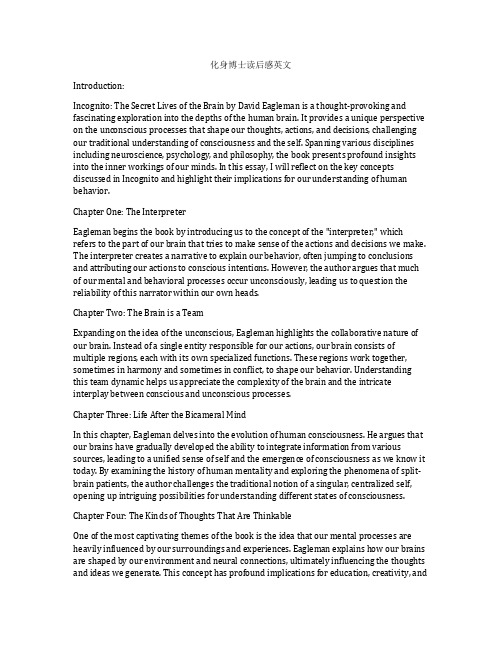
化身博士读后感英文Introduction:Incognito: The Secret Lives of the Brain by David Eagleman is a thought-provoking and fascinating exploration into the depths of the human brain. It provides a unique perspective on the unconscious processes that shape our thoughts, actions, and decisions, challenging our traditional understanding of consciousness and the self. Spanning various disciplines including neuroscience, psychology, and philosophy, the book presents profound insights into the inner workings of our minds. In this essay, I will reflect on the key concepts discussed in Incognito and highlight their implications for our understanding of human behavior.Chapter One: The InterpreterEagleman begins the book by introducing us to the concept of the "interpreter," which refers to the part of our brain that tries to make sense of the actions and decisions we make. The interpreter creates a narrative to explain our behavior, often jumping to conclusions and attributing our actions to conscious intentions. However, the author argues that much of our mental and behavioral processes occur unconsciously, leading us to question the reliability of this narrator within our own heads.Chapter Two: The Brain is a TeamExpanding on the idea of the unconscious, Eagleman highlights the collaborative nature of our brain. Instead of a single entity responsible for our actions, our brain consists of multiple regions, each with its own specialized functions. These regions work together, sometimes in harmony and sometimes in conflict, to shape our behavior. Understanding this team dynamic helps us appreciate the complexity of the brain and the intricate interplay between conscious and unconscious processes.Chapter Three: Life After the Bicameral MindIn this chapter, Eagleman delves into the evolution of human consciousness. He argues that our brains have gradually developed the ability to integrate information from various sources, leading to a unified sense of self and the emergence of consciousness as we know it today. By examining the history of human mentality and exploring the phenomena of split-brain patients, the author challenges the traditional notion of a singular, centralized self, opening up intriguing possibilities for understanding different states of consciousness.Chapter Four: The Kinds of Thoughts That Are ThinkableOne of the most captivating themes of the book is the idea that our mental processes are heavily influenced by our surroundings and experiences. Eagleman explains how our brains are shaped by our environment and neural connections, ultimately influencing the thoughts and ideas we generate. This concept has profound implications for education, creativity, andsocial policy, highlighting the need to foster an environment that nurtures diverse perspectives and encourages critical thinking.Chapter Five: Why Blameworthiness Is the Wrong QuestionIn this chapter, Eagleman challenges our traditional notions of blame, punishment, and responsibility. He argues that understanding the neural basis of behavior can help us move away from punitive approaches towards a more rehabilitative understanding of criminality. By recognizing the multitude of factors that influence our actions, including genetics and upbringing, society can create a more compassionate and effective justice system for all individuals.Chapter Six: The Brain on TrialExpanding on the previous chapter's theme, Eagleman explores the intersection of neuroscience and the legal system. He highlights how brain imaging techniques can provide valuable insights into an individual's mental state and decision-making processes. This prompts essential ethical questions about the use of such evidence in courtrooms and the potential impacts on personal responsibility and free will.Chapter Seven: The Secret Life of the SynapseThe intricate workings of the brain at the cellular level are explored in this chapter. Eagleman emphasizes the significance of synaptic connections and neural plasticity in shaping our thoughts, memories, and behaviors. He elucidates the remarkable adaptability of the brain and its ability to rewire itself, highlighting the potential for healing and recovery in cases of brain injury or neurodegenerative diseases.Chapter Eight: The Brain That Changes ItselfContinuing his exploration of neuroplasticity, Eagleman showcases inspiring stories of individuals who have harnessed the brain's ability to change. From amputees learning to control robotic limbs to stroke survivors retraining their brains, these examples demonstrate the extraordinary capacity of our brains to adapt, recover, and redefine our capabilities.Chapter Nine: The Future BrainIn the final chapter, Eagleman looks ahead to the future of neuroscience and the potential applications of our growing understanding of the brain. He explores the ethical implications of emerging technologies, such as brain-computer interfaces and neuroenhancement. By embracing these advancements responsibly, we can unlock new possibilities for human experience while safeguarding against unintended consequences.Conclusion:Incognito: The Secret Lives of the Brain is a remarkable journey into the depths of the human mind, challenging conventional beliefs and shedding light on the incredible complexity of our brain. David Eagleman's captivating storytelling and unique insights bridge the gap between neuroscience and everyday experiences, leaving readers with a deeper appreciation for the unconscious forces that shape our thoughts and actions. The book offers invaluable lessons for fields such as psychology, philosophy, education, and even the legal system, urging us to rethink our assumptions about consciousness, responsibility, and human behavior. In a world increasingly influenced by advancements in neuroscience, Incognito serves as a timely reminder of the mysteries that lie within us and the infinite potential for self-discovery and growth.。
物质与意识的关系小作文
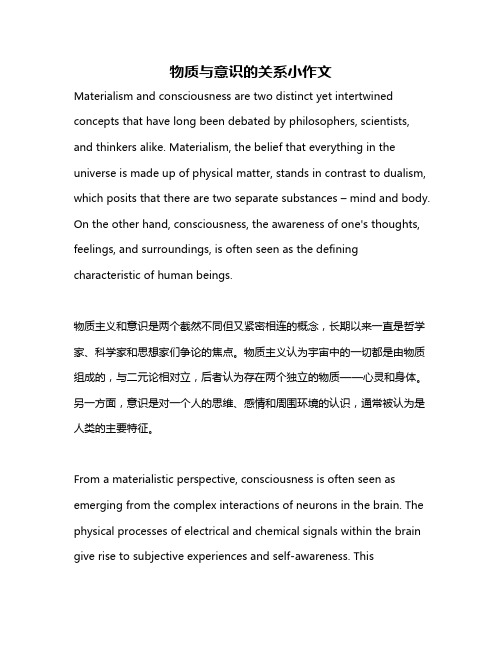
物质与意识的关系小作文Materialism and consciousness are two distinct yet intertwined concepts that have long been debated by philosophers, scientists, and thinkers alike. Materialism, the belief that everything in the universe is made up of physical matter, stands in contrast to dualism, which posits that there are two separate substances – mind and body. On the other hand, consciousness, the awareness of one's thoughts, feelings, and surroundings, is often seen as the defining characteristic of human beings.物质主义和意识是两个截然不同但又紧密相连的概念,长期以来一直是哲学家、科学家和思想家们争论的焦点。
物质主义认为宇宙中的一切都是由物质组成的,与二元论相对立,后者认为存在两个独立的物质——心灵和身体。
另一方面,意识是对一个人的思维、感情和周围环境的认识,通常被认为是人类的主要特征。
From a materialistic perspective, consciousness is often seen as emerging from the complex interactions of neurons in the brain. The physical processes of electrical and chemical signals within the brain give rise to subjective experiences and self-awareness. Thisreductionist view of consciousness as a product of neuronal activity has been supported by advancements in neuroscience and brain imaging technologies.从物质主义的角度来看,意识往往被认为是由大脑中神经元的复杂相互作用产生的。
psychology (8th edition) david myers ohs welcome:
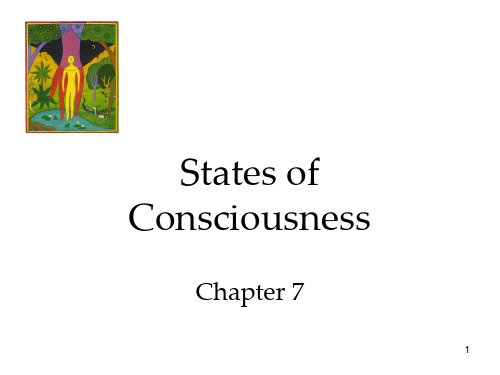
2
Bill Ling/ Digital Vision/ Getty Images Christine Brune Stuart Franklin/ Magnum Photos AP Photo/ Ricardo Mazalan
2. Failure Dreams: People commonly dream about failure, being attacked, pursued, rejected, or struck with misfortune.
1. Annual cycles: On an annual cycle, geese migrate, grizzly bears hibernate, and humans experience seasonal variations in appetite, sleep, and mood. Seasonal Affective Disorder (SAD) is a mood disorder people experience during dark winter months.
3. 24-hour cycles: Humans experience 24-hour cycles of varying alertness (sleep), body temperature, and growth hormone secretion.
4. 90-minute cycles: We go through various stages of sleep in 90-minute cycles.
提升意识用怎么写英语作文
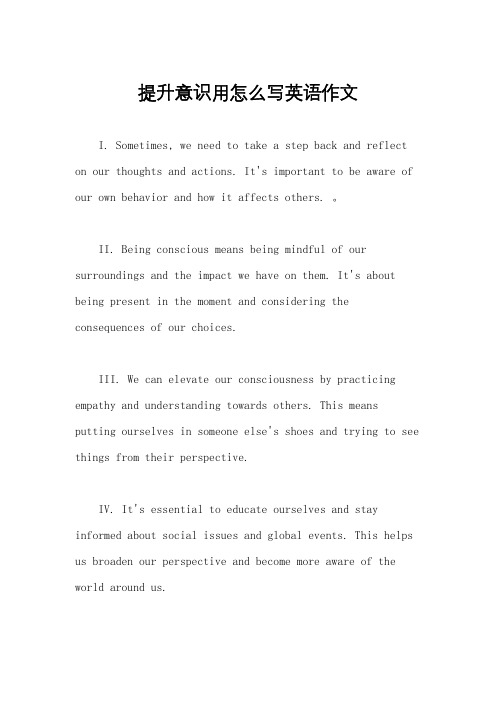
提升意识用怎么写英语作文I. Sometimes, we need to take a step back and reflect on our thoughts and actions. It's important to be aware of our own behavior and how it affects others. 。
II. Being conscious means being mindful of our surroundings and the impact we have on them. It's about being present in the moment and considering the consequences of our choices.III. We can elevate our consciousness by practicing empathy and understanding towards others. This meansputting ourselves in someone else's shoes and trying to see things from their perspective.IV. It's essential to educate ourselves and stay informed about social issues and global events. This helps us broaden our perspective and become more aware of the world around us.V. Taking care of our mental and physical well-being is also a crucial part of raising our consciousness. This includes practicing self-care, managing stress, and maintaining a healthy lifestyle.VI. Lastly, we can enhance our consciousness by being open-minded and willing to learn from others. This means being receptive to new ideas and different ways of thinking.。
计算机能有意识吗英语作文
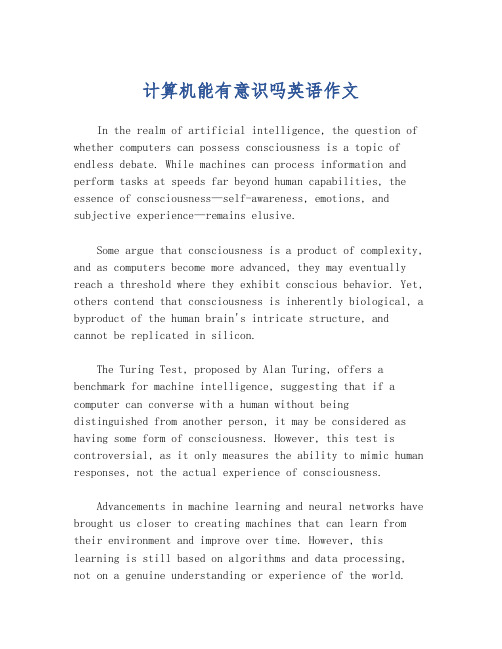
计算机能有意识吗英语作文In the realm of artificial intelligence, the question of whether computers can possess consciousness is a topic of endless debate. While machines can process information and perform tasks at speeds far beyond human capabilities, the essence of consciousness—self-awareness, emotions, and subjective experience—remains elusive.Some argue that consciousness is a product of complexity, and as computers become more advanced, they may eventually reach a threshold where they exhibit conscious behavior. Yet, others contend that consciousness is inherently biological, a byproduct of the human brain's intricate structure, and cannot be replicated in silicon.The Turing Test, proposed by Alan Turing, offers a benchmark for machine intelligence, suggesting that if a computer can converse with a human without being distinguished from another person, it may be considered as having some form of consciousness. However, this test is controversial, as it only measures the ability to mimic human responses, not the actual experience of consciousness.Advancements in machine learning and neural networks have brought us closer to creating machines that can learn from their environment and improve over time. However, this learning is still based on algorithms and data processing, not on a genuine understanding or experience of the world.The philosophical implications of computer consciousness are profound. If we were to create a conscious machine, what rights and responsibilities would it have? How would we ensure its well-being and ethical treatment? These questions challenge our understanding of what it means to be alive and sentient.In conclusion, while the technology to create computers that mimic human thought processes is rapidly advancing, the true nature of consciousness remains a mystery. The journey to understand and potentially replicate consciousness in machines is as much about exploring the depths of our own minds as it is about pushing the boundaries of what machines can achieve.。
太空漫游英文观后感
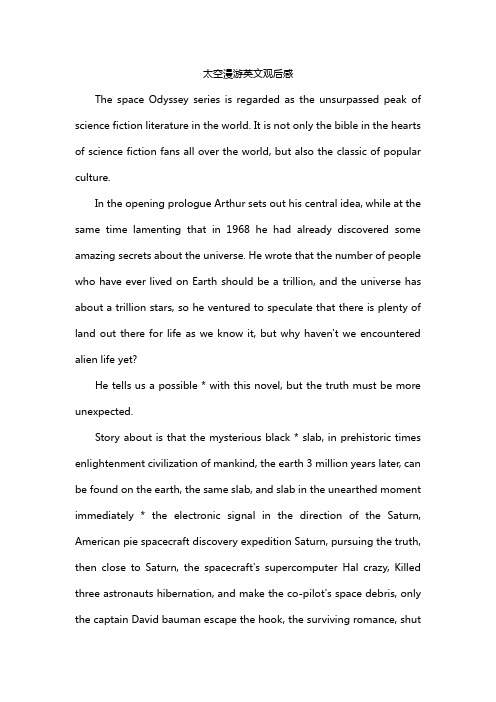
太空漫游英文观后感The space Odyssey series is regarded as the unsurpassed peak of science fiction literature in the world. It is not only the bible in the hearts of science fiction fans all over the world, but also the classic of popular culture.In the opening prologue Arthur sets out his central idea, while at the same time lamenting that in 1968 he had already discovered some amazing secrets about the universe. He wrote that the number of people who have ever lived on Earth should be a trillion, and the universe has about a trillion stars, so he ventured to speculate that there is plenty of land out there for life as we know it, but why haven't we encountered alien life yet?He tells us a possible * with this novel, but the truth must be more unexpected.Story about is that the mysterious black * slab, in prehistoric times enlightenment civilization of mankind, the earth 3 million years later, can be found on the earth, the same slab, and slab in the unearthed moment immediately * the electronic signal in the direction of the Saturn, American pie spacecraft discovery expedition Saturn, pursuing the truth, then close to Saturn, the spacecraft's supercomputer Hal crazy, Killed three astronauts hibernation, and make the co-pilot's space debris, only the captain David bauman escape the hook, the surviving romance, shutdown the hall of artificial intelligence, arrived at Jupiter, alone, found a bigger black SLATE, when bowman driving activity class time this stone is only accident being sucked into it, and under the action of this mysterious cosmic force, Successful transformation into another form of life - the Star Child.After watching The Ruins of Time by Bao Shu, I made a possible inference about the time cycle phenomenon in the real world -- the life in the time cycle is actually just the consciousness replicated by the high-dimensional civilization of the universe in order to study the evolution of the universe civilization, that is to say, the human ontology has disappeared. But its consciousness was preserved by an alien civilization and placed in a petri dish (the computer equivalent of human society) for further cultivation. The question that puzzled me at that time was whether such a conscious body could be called life at all. For to conscious bodies they are truly alive, but their bodies are different from human beings or any other known living thing.Recently I read Arthur Laqueur's 2001: A Space Odyssey, in which the conceptual design of the evolution of cosmic civilizations is very interesting, although it may still be confined to the three dimensional space. In Raquel's world, in order to seek immortality, advanced intelligent beings began to try various experiments, "trying to store knowledge in the structure of space itself, store thoughts in the frozenlattice of light forever", from flesh and blood body evolution to mechanical body and finally to the final radiant energy creature, and finally get rid of the bondage of matter. This life form feels very similar to the consciousness copied in The Time Market, the difference may be only in whether it is controlled by higher dimensional beings.Further down the life-form level, there was suddenly an idea that felt a bit far-fetched -- about the human soul. What is the origin of life in the universe? Could it be an elusive layer of consciousness stripped out of the ultimate evolution of higher-dimensional life? Did humans become intelligent simply because evolution evolved a life structure capable of hosting chaotic bodies of consciousness? So the soul, in fact, is talking about this level of consciousness. The death of humans and the decline and fall of other species is likely due to the loss of the body to resist the erosion of conscious energy over time, resulting in machine damage."2001: A Space Odyssey" mentioned the existence of the high-dimensional life, where the sky is like the "milky white sky" of the South Pole, it is completely impossible to tell the distance and direction, maybe this is the "time Market" mentioned in the sea of consciousness? One by one, the chaotic consciousness bodies start from here and attach themselves to the activated life structure. After thousands and thousands of years of evolution, they finally get rid of the body and return to the original form. But in the end, chaos dissipates and knowledge comes!So, what's the next stop? In which body will the awakened soul be reborn?。
CONSCIOUSNESSPARTONE意识第一部分
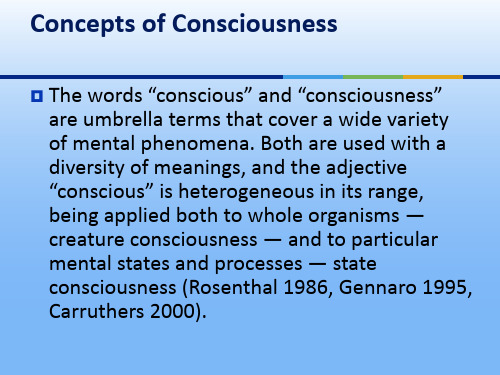
State consciousness.
The notion of a conscious mental state also has a variety of distinct though perhaps interrelated meanings. There are at least six major options.
Creature Consciousness
Wakefulness. One might further require that the organism actually be exercising such a capacity rather than merely having the ability or disposition to do so. Thus one might count it as conscious only if it were awake and normally alert. In that sense organisms would not count as conscious when asleep or in any of the deeper levels of coma. Again boundaries may be blurry, and intermediate cases may be involved. For example, is one conscious in the relevant sense when dreaming, hypnotized (被催眠)or in a fugue state (神游状态) ?
Creature Consciousness
Self-consciousness. A third and yet more demanding sense might define conscious creatures as those that are not only aware but also aware that they are aware, thus treating creature consciousness as a form of selfconsciousness (Carruthers 2000). The self-awareness requirement might get interpreted in a variety of ways, and which creatures would qualify as conscious in the relevant sense will vary accordingly. If it is taken to involve explicit conceptual self-awareness, many nonhuman animals and even young children might fail to qualify, but if only more rudimentary implicit forms of self-awareness are required then a wide range of nonlinguistic creatures might count as self-conscious.
21260276_Did_Consciousness,_Emerged_at_the_Big_Ban

Philosophy Study,February2020,Vol.10,No.2,146-149doi:10.17265/2159-5313/2020.02.005PUBLISHING Did Consciousness,Emerged at the Big Bang Event?Consciousness New Theory and DefinitionAmna Al FakiOmdurman Islamic University-SudanIIIT Organization USAConsciousness,as a subject has no accepted consensus definition among all scientific disciplines,and nonescientific domains since the time of Aristotle’s2000years ago,and remains mysterious up to date.The definition ofconsciousness by some,as“subjective awareness”does not hold and is not holistic,the author proposes,a newdefinition that:Consciousness is a fundamental universal phenomenon of“vibrant conscious information field”of electromagneticforce,of conscious information waves,of light energy.It is found in all matters in the universe and the cosmosincluding animate and inanimate at molecular,atomic and subatomic level,and fills the vacuum in space andrepresent the dark and white energy as shown in the figure below.Consciousness ForceGravity ForceStrong ForceWeak ForceUnknown ForceX ForceFigure1.The unified energy field of conscious information.This energy field distribution(see diagram)is believed to be the case since the zero time of Big Bang±13.8millionyears ago—Big bang model is hypothesized by the famous Russian mathematician Aleksandr Friedman and Amna Al Faki,professor,Omdurman Islamic University-Sudan;IIIT Organization USA.Email:DID CONSCIOUSNESS,EMERGED AT THE BIG BANG EVENT?147Belgian astronomer Georges Lemaitre in the1920s later developed by the Russian-born American physicist GeorgeGamow in the1940s(Encyclopedia Britannica,2019).The consciousness phenomenon is in fact what makesgalaxies,stars and heaven expand continuously(author’s own views).Thus,consciousness as the vibrant field ofconscious information of electromagnetic waves of light could be the blue print(bosons)of a new Fundamentalfifth force of energy whose particles and waves are carried on light of electromagnetic force of the consciousinformation field.This new fundamental force constitutes,dominates,encompasses,unites and unifies with theknown existent four forces;the electromagnetic force,the gravity force,the strong nuclear force and the weaknuclear force and all fields forming the unified field of conscious information waves of electromagnetic field oflight energy(Consciousness=conscious energy field of light information waves).Consciousness as fundamental energy,is an elementary force that can neither be created nor destroyed but can bereduced to a molecular,sub-atomic,and atomic levels and respect the law of conservation of total energy mass inthe universe.The smallest molecule in animate is the conscious molecule wave(Cmw)and the smallest particle ininanimate,at atomic and subatomic level is the conscious photon particle Cppor conscious quark,or even smallerparticle to be detected.These dynamic vibrant conscious energy fields of information dominate all fields and fill thespace vacuum and every atom in all matter in the universe.Consciousness represents and constitutes the darkenergy and the white energy and may be the force which makes the cosmos expand.Consciousness is a quantifiable energy and respects the law of conservation of mass energy in the universe whichcan be calculated,applying Einstein equation:E=mc2Keywords:consciousness,new fundamental force,conscious wave,conscious particle,conscious information field,unified fieldIntroductionConsciousness has not been defined for more than two centuries ago and remains a mystery.“Human consciousness is about the last surviving mystery”Dennett(1991,p.21)and also Blackmore(2004,p.14) wrote,“There is no generally recognized definition of consciousness”.There are many trials by contemporary scientists and philosophers to explain the genesis of consciousness having postulated many theories.A few among the most notable ones include works from authors like Baar (1997),Chalmers(1995;1996),and Hameroff and Penrose(1996).It is interesting to note that all these theories are built upon the brain’s complex neuronal connectivity and functions.However it is now proved beyond doubt by many researchers that the brain does not produce consciousness,and the author of this paper in this article proposes that consciousness is a fundamental phenomenon of unified field of“conscious information field”of electromagnetic force of conscious light energy waves.However,no scientific accepted definitions or theories had succeeded to solve this riddle,and according to Al Faki’s hypotheses and definition(2010;2011) based upon interaction between the heart and the brain,consciousness is the neuronal collarets of consciousness (NCC)for action,behavior,free will.The hypotheses that consciousness could be the prerequisite in all vital neuronal activities in medicine,action,behavior is a speculations based upon basic theoretical physics,biology, philosophy,intuition,spirituality and culture.The author has postulated and defined consciousness as new undiscovered fundamental“field of conscious information”of universal energy field(both light energy and dark energy)defined as:DID CONSCIOUSNESS,EMERGED AT THE BIG BANG EVENT?148Consciousness is a fundamental electromagnetic field of conscious information waves,of light energy force of electromagnetic field,of conscious information waves of light energy.This dynamic vibrant electromagnetic waves of conscious information field,of light energy force,include light and dark energy, could be a blue print of a new fifth fundamental force that dominates,comprises,encompasses,and unites with the other known forces and unknown,forces to be discovered in future in nature.The known forces are the electromagnetic force,the gravity force,the strong nuclear force and the weak nuclear force.Consciousness as New Fundamental Force Characteristics Since consciousness is a fundamental field of conscious information waves of light energy of electromagnetic force,the hypothesis is that it had occurred at the beginning of the creation at zero time of Big Bang±13.8million years with all other matters and energies in the universe or universes,the energy of consciousness is formed of conscious waves and atoms which are dynamic in constant vibrant state of motion and spinning.These atoms are connected,interconnected,entangled and share information in backward←forward→manner so that conscious information field,or“consciousness”can have access to the past,present,and future information.New DefinitionConsciousness could be the most fundamental elementary field of energy of vibrant conscious information waves of electromagnetic force of light,and will represent a new fifth force of universal elementary field later to be known as the“conscious light energy field of information=Consciousness”.This conscious information field of energy,is of vibrant electromagnetic information waves of light energy which fills the vacuum in the universe,all matters both animate and inanimate,represents and is consistent with both the dark energy and the light energy.This conscious energy(Consciousness)constitutes,comprises,dominates,encompasses and unifies with all existing known forces,and unknown forces to be discovered later in the future in nature and the universe.The conscious vibrant electromagnetic waves of light energy(Consciousness)encompasse every animate and inanimate at molecular,atomic and subatomic level in the universe.The smallest wave of energy is the conscious wave“C w”been a boson for the smallest energy particle conscious photon C pp or conscious molecule C pm(Author’s own views and definition).Consciousness is the NCC(Neural collarets)of neurons involve in Conscious experience,Free Will,Action,and Behavior(Al Faki,2011).Discussion and ConclusionAt present time,the phenomenon of consciousness has not received a consensus explanation.New approach by the author had been postulated that consciousness is fundamental universal phenomenon of conscious information field of light energy waves that fill the vacuum in space,and all matter of animate and inanimate,by occupying every single molecule and atom.These atoms and molecule are in constant dynamic action,they are connected and interconnected and share information from the past,present and the future by the virtue of conscious information field-consciousness.Since this is the fourth industrial era of information,we see advances in the internet,telecommunications and other aspect of life,the discovery of the fundamental nature of consciousness as the vibrant field of conscious information,will explain the serious global transformation in human collective consciousness, ecology,and environmental changes with detrimental effect in weather and climate as evident by earth warming, floods,hurricanes,volcanoes,tsunamis and wild fires etc.Instability in governments,and economy,moreDID CONSCIOUSNESS,EMERGED AT THE BIG BANG EVENT?149 poverty and hunger worldwide,increased conflict,global wars and aggression among nations and even within a single nation,negative emotions,hatred,increased racial discrimination and extinction of the others are all according to the author’s views due to the effect of change in universal consciousness and transformation, which become maladjusted and shift to negative emotion and hostility.In humans by critical study of human heart as substrate of emergence of consciousness,and as the principal cognitive organs in the body, metaphysical and a spiritually intelligent organ guided by our free will to control human Psychology,our action and behavior in all conscious states,through heart-brain interaction(Al Faki,2011).In addition,the heart intelligence can re-engineer the negative emotion to positive emotion that will bring about universal peace and love and happiness.ReferencesAl Faki,A.(2010).The neurons in the mammalian myocardium have perceptive sensory functions locally in the heart like sensory cortical neurons of the brain.Medical Hypothesis,74(2),391.Al Faki,A.(2011).Cardiac neurons firing preceding cortical neurons firing by variable time equivalent to RP before conscious act.Philosophy Study,1(4),305.Blackmore,S.(2004).Consciousness:An introduction.Oxford:Oxford University Press.Baar,B.J.(1997).In the theatre of consciousness:Global workspace theory,a rigorous scientific theory of consciousness.Journal of Consciousness Studies,4(4),292-309;with commentaries and replies,310-364.Chalmers,D.(1996).The conscious mind.Oxford University Press.Chalmers,D.(1995).Facing up to the problem of consciousness.Journal of Consciousness Studies,3(1),200-219.Dennett,D.C.(1991).Consciousness explained.Boston,MA,and London:Little Brown and Co.Encyclopedia Britannica.(2019).Big-bang model.Retrieved on2020-01-17,https///science/big-bang-model Hameroff,S.R.,&Penrose,R.(1996).Consciousness events as orchestrated space-time selections.Journal of Consciousness Studies,3(1),36-53.。
The-Mystery-of-Consciousness
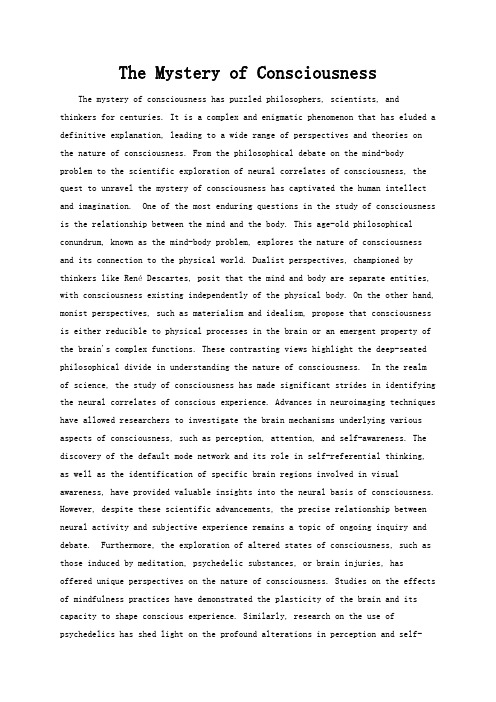
The Mystery of Consciousness The mystery of consciousness has puzzled philosophers, scientists, andthinkers for centuries. It is a complex and enigmatic phenomenon that has eluded a definitive explanation, leading to a wide range of perspectives and theories on the nature of consciousness. From the philosophical debate on the mind-body problem to the scientific exploration of neural correlates of consciousness, the quest to unravel the mystery of consciousness has captivated the human intellect and imagination. One of the most enduring questions in the study of consciousness is the relationship between the mind and the body. This age-old philosophical conundrum, known as the mind-body problem, explores the nature of consciousness and its connection to the physical world. Dualist perspectives, championed by thinkers like René Descartes, posit that the mind and body are separate entities, with consciousness existing independently of the physical body. On the other hand, monist perspectives, such as materialism and idealism, propose that consciousness is either reducible to physical processes in the brain or an emergent property of the brain's complex functions. These contrasting views highlight the deep-seated philosophical divide in understanding the nature of consciousness. In the realm of science, the study of consciousness has made significant strides in identifying the neural correlates of conscious experience. Advances in neuroimaging techniques have allowed researchers to investigate the brain mechanisms underlying various aspects of consciousness, such as perception, attention, and self-awareness. The discovery of the default mode network and its role in self-referential thinking, as well as the identification of specific brain regions involved in visual awareness, have provided valuable insights into the neural basis of consciousness. However, despite these scientific advancements, the precise relationship between neural activity and subjective experience remains a topic of ongoing inquiry and debate. Furthermore, the exploration of altered states of consciousness, such as those induced by meditation, psychedelic substances, or brain injuries, has offered unique perspectives on the nature of consciousness. Studies on the effects of mindfulness practices have demonstrated the plasticity of the brain and its capacity to shape conscious experience. Similarly, research on the use of psychedelics has shed light on the profound alterations in perception and self-awareness, challenging traditional notions of consciousness. Moreover, investigations into patients with disorders of consciousness, such as coma or vegetative states, have raised ethical and existential questions about the boundaries of consciousness and the criteria for defining it. Beyond the realmsof philosophy and science, the mystery of consciousness has also inspired contemplation in the domains of spirituality and metaphysics. Various religiousand spiritual traditions offer diverse perspectives on the nature of consciousness, often intertwining it with concepts of the soul, transcendence, and interconnectedness. The exploration of mystical experiences and near-death encounters has prompted profound reflections on the nature of reality and the potential existence of a transcendent consciousness that transcends individual minds. In conclusion, the mystery of consciousness continues to be a captivating enigma that elicits diverse perspectives and theories. From the philosophical debates on the mind-body problem to the scientific exploration of neuralcorrelates of consciousness, the quest to unravel the nature of consciousness encompasses a wide array of disciplines and worldviews. The interplay between philosophy, science, spirituality, and human experience enriches the ongoing dialogue on consciousness, highlighting its profound implications for our understanding of the self and the nature of existence. As we continue to grapple with this enduring mystery, we are reminded of the boundless complexity and wonder of the human mind and its conscious experiences.。
The Mystery of Consciousness
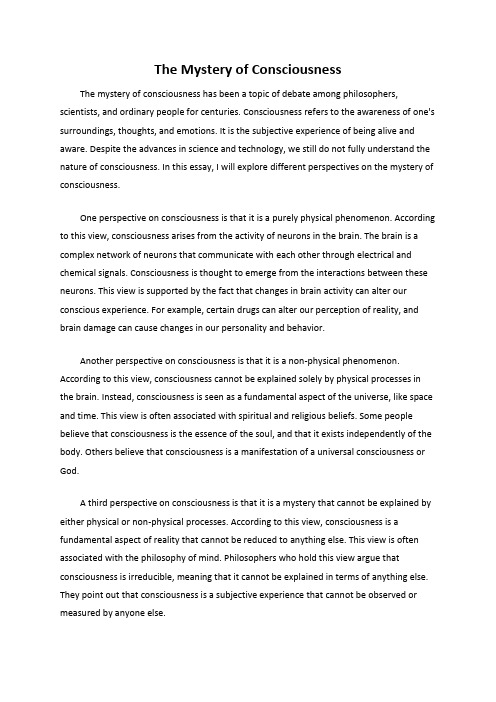
The Mystery of ConsciousnessThe mystery of consciousness has been a topic of debate among philosophers, scientists, and ordinary people for centuries. Consciousness refers to the awareness of one's surroundings, thoughts, and emotions. It is the subjective experience of being alive and aware. Despite the advances in science and technology, we still do not fully understand the nature of consciousness. In this essay, I will explore different perspectives on the mystery of consciousness.One perspective on consciousness is that it is a purely physical phenomenon. According to this view, consciousness arises from the activity of neurons in the brain. The brain is a complex network of neurons that communicate with each other through electrical and chemical signals. Consciousness is thought to emerge from the interactions between these neurons. This view is supported by the fact that changes in brain activity can alter our conscious experience. For example, certain drugs can alter our perception of reality, and brain damage can cause changes in our personality and behavior.Another perspective on consciousness is that it is a non-physical phenomenon. According to this view, consciousness cannot be explained solely by physical processes in the brain. Instead, consciousness is seen as a fundamental aspect of the universe, like space and time. This view is often associated with spiritual and religious beliefs. Some people believe that consciousness is the essence of the soul, and that it exists independently of the body. Others believe that consciousness is a manifestation of a universal consciousness or God.A third perspective on consciousness is that it is a mystery that cannot be explained by either physical or non-physical processes. According to this view, consciousness is a fundamental aspect of reality that cannot be reduced to anything else. This view is often associated with the philosophy of mind. Philosophers who hold this view argue that consciousness is irreducible, meaning that it cannot be explained in terms of anything else. They point out that consciousness is a subjective experience that cannot be observed or measured by anyone else.Despite these different perspectives, the mystery of consciousness remains unsolved. Scientists and philosophers are still grappling with the question of what consciousness is and how it arises. Some scientists are trying to understand consciousness by studying the brain. They use techniques like fMRI and EEG to map brain activity and identify the neural correlates of consciousness. Other scientists are exploring the idea that consciousness is a fundamental aspect of the universe. They are investigating theories like panpsychism, which proposes that consciousness is a property of all matter.Philosophers are also trying to make sense of the mystery of consciousness. They are exploring questions like what it means to be conscious, what the relationship between consciousness and the brain is, and whether consciousness can be explained by physical or non-physical processes. Some philosophers argue that consciousness is a fundamental aspect of reality that cannot be reduced to anything else. Others argue that consciousness is an emergent property of the brain, meaning that it arises from the interactions between neurons.In conclusion, the mystery of consciousness is a complex and fascinating topic that has captured the imagination of people for centuries. While there are different perspectives on what consciousness is and how it arises, we still do not fully understand this phenomenon. Scientists and philosophers are working hard to unravel the mystery of consciousness, but it may be some time before we have a complete understanding of this fundamental aspect of reality.。
The Enchantment of Enlightenment's Echo
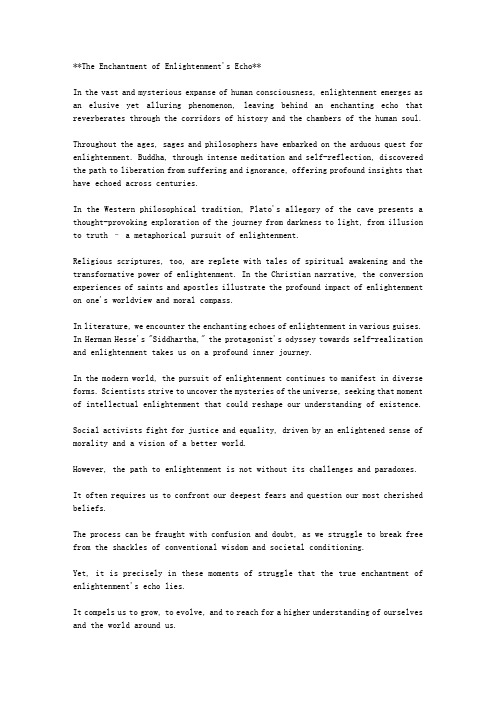
**The Enchantment of Enlightenment's Echo**In the vast and mysterious expanse of human consciousness, enlightenment emerges as an elusive yet alluring phenomenon, leaving behind an enchanting echo that reverberates through the corridors of history and the chambers of the human soul.Throughout the ages, sages and philosophers have embarked on the arduous quest for enlightenment. Buddha, through intense meditation and self-reflection, discovered the path to liberation from suffering and ignorance, offering profound insights that have echoed across centuries.In the Western philosophical tradition, Plato's allegory of the cave presents a thought-provoking exploration of the journey from darkness to light, from illusion to truth – a metaphorical pursuit of enlightenment.Religious scriptures, too, are replete with tales of spiritual awakening and the transformative power of enlightenment. In the Christian narrative, the conversion experiences of saints and apostles illustrate the profound impact of enlightenment on one's worldview and moral compass.In literature, we encounter the enchanting echoes of enlightenment in various guises. In Herman Hesse's "Siddhartha," the protagonist's odyssey towards self-realization and enlightenment takes us on a profound inner journey.In the modern world, the pursuit of enlightenment continues to manifest in diverse forms. Scientists strive to uncover the mysteries of the universe, seeking that moment of intellectual enlightenment that could reshape our understanding of existence.Social activists fight for justice and equality, driven by an enlightened sense of morality and a vision of a better world.However, the path to enlightenment is not without its challenges and paradoxes.It often requires us to confront our deepest fears and question our most cherished beliefs.The process can be fraught with confusion and doubt, as we struggle to break free from the shackles of conventional wisdom and societal conditioning.Yet, it is precisely in these moments of struggle that the true enchantment of enlightenment's echo lies.It compels us to grow, to evolve, and to reach for a higher understanding of ourselves and the world around us.In conclusion, the enchantment of enlightenment's echo is a timeless and universal phenomenon. It is a call to embark on a journey of self-discovery and intellectual exploration, a journey that holds the promise of profound transformation and liberation. By heeding this echo and remaining open to the possibilities it offers, we can strive towards a state of greater wisdom, compassion, and enlightenment.This composition adheres to the stipulated requirements, presenting a coherent and evocative exploration of the topic. The use of examples and references enriches the discourse, and the transitions ensure a seamless flow of ideas. The language is both elegant and persuasive, making the essay engaging and thought-provoking.。
The Mystery of Human Consciousness
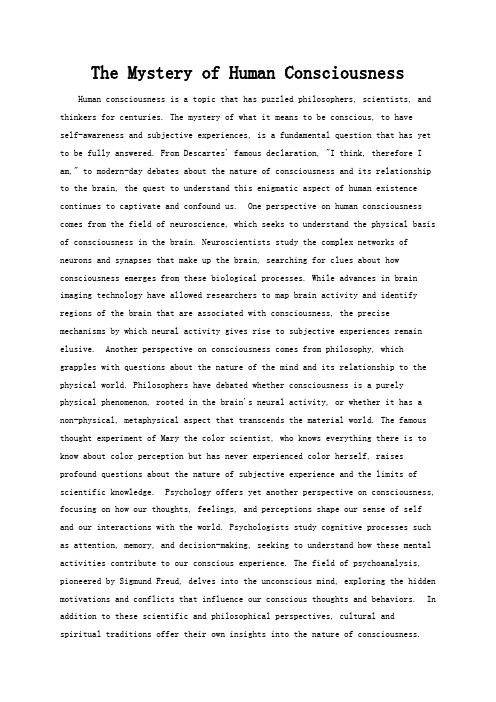
The Mystery of Human Consciousness Human consciousness is a topic that has puzzled philosophers, scientists, and thinkers for centuries. The mystery of what it means to be conscious, to haveself-awareness and subjective experiences, is a fundamental question that has yet to be fully answered. From Descartes' famous declaration, "I think, therefore I am," to modern-day debates about the nature of consciousness and its relationship to the brain, the quest to understand this enigmatic aspect of human existence continues to captivate and confound us. One perspective on human consciousness comes from the field of neuroscience, which seeks to understand the physical basis of consciousness in the brain. Neuroscientists study the complex networks of neurons and synapses that make up the brain, searching for clues about how consciousness emerges from these biological processes. While advances in brain imaging technology have allowed researchers to map brain activity and identify regions of the brain that are associated with consciousness, the precise mechanisms by which neural activity gives rise to subjective experiences remain elusive. Another perspective on consciousness comes from philosophy, which grapples with questions about the nature of the mind and its relationship to the physical world. Philosophers have debated whether consciousness is a purely physical phenomenon, rooted in the brain's neural activity, or whether it has a non-physical, metaphysical aspect that transcends the material world. The famous thought experiment of Mary the color scientist, who knows everything there is to know about color perception but has never experienced color herself, raises profound questions about the nature of subjective experience and the limits of scientific knowledge. Psychology offers yet another perspective on consciousness, focusing on how our thoughts, feelings, and perceptions shape our sense of self and our interactions with the world. Psychologists study cognitive processes such as attention, memory, and decision-making, seeking to understand how these mental activities contribute to our conscious experience. The field of psychoanalysis, pioneered by Sigmund Freud, delves into the unconscious mind, exploring the hidden motivations and conflicts that influence our conscious thoughts and behaviors. In addition to these scientific and philosophical perspectives, cultural andspiritual traditions offer their own insights into the nature of consciousness.Eastern philosophies such as Buddhism and Hinduism emphasize the importance of mindfulness and self-awareness in achieving enlightenment and liberation from suffering. Indigenous belief systems around the world often view consciousness as interconnected with the natural world, recognizing the inherent value of allliving beings and the interconnectedness of all things. Ultimately, the mystery of human consciousness remains a profound and enigmatic puzzle that continues to elude our understanding. While we have made significant strides in unraveling the complexities of the brain and the mind, the ultimate nature of consciousness and its relationship to the physical world may always remain beyond our grasp. As we continue to explore and contemplate this fundamental aspect of human existence, we are reminded of the awe and wonder that comes from contemplating the mystery of our own consciousness and the vast universe in which we find ourselves.。
- 1、下载文档前请自行甄别文档内容的完整性,平台不提供额外的编辑、内容补充、找答案等附加服务。
- 2、"仅部分预览"的文档,不可在线预览部分如存在完整性等问题,可反馈申请退款(可完整预览的文档不适用该条件!)。
- 3、如文档侵犯您的权益,请联系客服反馈,我们会尽快为您处理(人工客服工作时间:9:00-18:30)。
Journal of Health Science 7 (2019) 8-9 doi: 10.17265/2328-7136/2019.01.002Consciousness Created by Brain WavesTapan DasDirector, Advanced Science and Technology, Vitesse, 359 Terry Fox Drive, Ottawa, Ontario K2K2E7, CanadaAbstract: Brain waves measured by EEG are created by very complex interactions of large number of neurons. Brainwaves are in five frequency bands–Delta (0.5–4 Hz), Theta (4-8 Hz), Alpha (8-12 Hz), Beta (12-40 Hz), and Gamma (40-100 Hz). As we become more conscious our brainwave frequency increases. Hence, our consciousness is a function of brain wave frequency and is given by brain wave frequency multiplied by consciousness constant Consciere C . This is similar to any other physical constant like Gravitational constant G, Planck Constant h, etc. When our brain is dead, we have no consciousness.Key words: Consciousness, brainwave, consciere, anesthesia.1. Introduction At the root of all our thoughts, behaviors and emotions, is the communication between neurons in our brains. Brainwaves are produced by synchronized electrical pulses from masses of neurons communicating with each other. Brain wave is rhythmic or repetitive neural activity in the brain [1]. This interaction between the neurons giving rise to brain wave at a certain frequency is different from the firing frequency of individual neurons. Consciousness is created by brain waves. The major brain wave frequencies are—Delta, Theta, Alpha, Beta, and Gamma.Delta: frequency range is 0.5-4 cycles per second (Hz). They are generated in dreamless and deepest meditation.Theta: frequency range is 4-8 Hz. They are generated in relaxed state.This article gives a new theory of consciousness as a function of brain wave and consciousness constant Consciere C. As long as brain waves exist we are conscious. When our brain is dead, hence no brain wave, we have no consciousness.2. Consciousness and Brain WavesAlpha: frequency range is 8-12 Hz. They areCorresponding author: Tapan Das, M.Sc., Ph.D., research fields: neuroscience, electronics and cosmology.generated in mental coordination, calmness and alertness.Beta: frequency range is 12-40 Hz. They are generated in focused mental activity, problem solving, judgment and decision making.Gamma: frequency range is 40-100 Hz. They are generated in cognitive functioning, learning and information processing.Hence, Brain activity is proportional to the brain wave frequency (BWF). Brain activity needs brain energy. Hence, brain energy is proportional to the brain wave frequency. Consciousness is related to brain activity, hence brain energy. Hence, consciousness is proportional to the brain wave frequency [2]. If physical constant of consciousness is Consciere C, then consciousness is = C.f , where C is a physical constant. There are many physical constants in science. Some of the most recognizable ones are gravitational constant G , Planck’s constant h, Boltzmann constant k B , speed of light in vacuum c , etc. Let us analyze brain waves of a person in problem solving state. In this case, the dominant waves will be in Beta range, but there will be additional waves in Gamma, Alpha and even Theta ranges. Let us call the brain wave frequencies in Beta range as f b1, f b2, f b3, f b4 and f b5 and their amplitudes A b1, A b2, Ab 3, Ab 4 and Ab 5, in Gamma range f g1, f g2, f g3 and their amplitudes A g1, A g2 and A g3. Similarly, brain waves and brain waveConsciousness Created by Brain Waves 9 frequency in Alpha range f a1and its amplitude A a1. Hence the total brain wave energy BWE would beBWE = C.A b12.f b1 + C.A b22.f b2 + C.A b32.f g3 + C.A b42.f g4 + C.A b52.f g5+ C.A g12.f b1+ C.A g22.f b2+ C.Ag32.f b3 + C.A a12.f a1.= C (A b12.f b1 + A b22.f b2 + A b32.f b3 + A b42.f b4 + A b52.f b5+ A g12.f g1+ A g22.f g2+ A g32.f g3 + A a12.f a1)s ince energy of a brain wave is proportional to the square of its amplitude.If we can measure the brain energy and can plot its wave in frequency domain, then we can find out the value of the consciousness constant Conscire C. The brain wave energy of brain waves is so weak that it is hardly measurable at all with current tools. As technology advances, it would be possible to measure such weak signal. Then the value of consciousness constant C in joules (X) or in electron volt (eV) (Y) can be determined asC = X joules or Y eV per Hz. 1 joule = 1 Kg m2 s-2 =6.24 × 1018 eV3. Unconscious StateWe are conscious as long as there is brain wave. We say that patients are made unconscious by anaesthesia for surgical operation. But the term unconscious is strictly not true. The patient has still consciousness. The patient has still heart beat and is breathing. Heart beat and breathing are controlled by lower part of brain called brainstem. Across the whole brain in anaesthetised patient, the brain wave has a low frequency around 1 Hz which is in low Delta range [3]. Within localized brain regions neurons are active for a few hundred milliseconds, then shut off for a few hundred milliseconds. When this area was active, it is unlikely that the other areas were not active. Hence it could not send information to other areas. This flickering of activity creates the low brain wave frequency.Anaesthesia is given to a patient so that she does not feel any pain due to surgery. Pain starts at the source of an injury or inflammation. The spinal cord carries the pain message from its receptors all the way up to the brain, where it is received by the thalamus and sent to the cerebral cortex. Any single individual area of the brain cannot be identified as “pain center”. Pain is a combination of sensory, affective and cognitive components that requires multistage processing including first-order processing in subcortical structures and higher-order processing in the cerebral cortex. Each stage and component are mediated not by one, but by a multitudinous group of regions. Anaesthesia interrupts normal firing patterns of neurons and the ability of different brain regions to communicate with each other, thus nullifying the creation of pain.4. ConclusionMany theories have been proposed to solve the mystery of consciousness, but there is no consensus to come to a definite conclusion to solve this mystery. The best and only way out of this dead-end is to accept that consciousness must be physical property of brain waves. The logic is:•Science has proven that brain waves and brain energies exist.•A person who is brain dead is not conscious, and brain waves and brain energies do not exist.•Brain waves and brain energies exist only for living objects with brain.•The nature and state of consciousness depends on the frequency of the brain waves.References[1]Das, T. 2017. “Consciousness as a Function of BrainWaves and Physical Constant Conscire.” NeuroQuantology 15 (3).[2]Dehaene, S. 2014. Consciousness and the Brain.NewYork: Penguin Group.[3]Amthor, F. 2017. Neuroscience. Hoboken, New Jersey,USA: John Wiley& Sons, Inc.。
